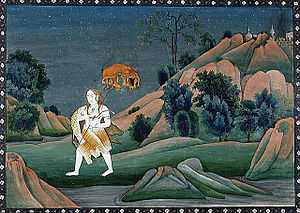Guhyeshwari Temple
| Guhyeshwari Temple | |
|---|---|
 Guhyeshwari Temple Location in Nepal
| |
| Coordinates: | 27°42′40″N 85°21′12″E / 27.71111°N 85.35333°ECoordinates: 27°42′40″N 85°21′12″E / 27.71111°N 85.35333°E |
| Name | |
| Devanagari: | गुह्येश्वरी |
| Location | |
| Country: | Nepal |
| District: | Kathmandu |
| Location: | Kathmandu |
| Architecture and culture | |
| Primary deity: | Shiva, Parvati |
| Important festivals: | Shivaratri, Teej, Balachaturdasi |
| Architectural styles: | Pagoda |
Guhyeshwari Temple (Nepali: गुह्येश्वरी मन्दिर), also spelled Guheswari or Guhjeshwari, is one of the revered holy temples in Kathmandu, Nepal. This temple is dedicated to Adi Shakti. The temple is a Shakti Peetha near to the Pashupatinath Temple. It is said that this temple is the Shakti chair of Pasupanath Temple. King Pratap Malla built this temple in the 17th century.
The temple name originates from the Sanskrit words Guhya (Secret) and Ishwari (Goddess). In 'Lalitha Sahasranama' the 707th name of Goddess is mentioned as 'Guhyarupini' (The form of Goddess is beyond human perception and it is secret. Another argument is that it is the secret 16th syllable of the Shodashi Mantra)(LS 137th verse: Sarasvati shastramayi| Guhaamba guhyaruupini||).[1] It is believed that Sati Devi's corpse's parts fell in different region when Shiva took it and roamed around the world in sorrow. The Temple of Guhyeshwari lies about 1 km east of Pasupanath and is located near the banks of the Bagmati River.[2]
The Temple as a Shakti Peeth

The mythology of Daksha yaga and Sati's self immolation had immense significance in shaping the ancient Sanskrit literature and even had impact on the culture of India. It led to the development of the concept of Shakti Peethas and there by strengthening Shaktism. Enormous mythological stories in puranas took the Daksha yaga as the reason for its origin.[3][4][5]
Shakti Peethas are shrines or divine places of the Mother Goddess. These are places that are believes to have enshrined with the presence of Shakti due to the falling of body parts of the corpse of Sati Devi, when Lord Shiva carried it and wandered throughout Aryavartha in sorrow. There are 51 Shakti Peeth linking to the 51 alphabets in Sanskrit. Each temple have shrines for Shakti and Kalabhairava. The Shakti is Mahashira and the Bhairava is Kapali. This temple is revered by Tantric practitioners and Tantric rites are performed in this temple.
Worship
During the Navrathri festival the King of Nepal accompanied by his families worships here after talking a holy bath in the river Bagmati. There are many believes related to the temple
- It is believed that if a marriage take place in the Guhyeshwari temple, the couples will be soul mates for another 6 birth. Sati (goddess) married Shiva, and was reborn as Parvati on her next birth.
- Women worship in Guhyeshwari Temple to improve health of their husband.
- Worship done here leads to victory over enemies.
References
- ↑ "Shakti Sadhana Org: : LalithA SahasranAma". shaktisadhana.50megs.com. Retrieved 2014-01-25.
- ↑ "Kathmandu page 4". virtualtraveling.endesign.nl. Retrieved 2014-01-25.
- ↑ (Translator), F. Max Muller (June 1, 2004). The Upanishads, Vol I. Kessinger Publishing, LLC. ISBN 1419186418.
- ↑ (Translator), F. Max Muller (July 26, 2004). The Upanishads Part II: The Sacred Books of the East Part Fifteen. Kessinger Publishing, LLC. ISBN 1417930160.
- ↑ "Kottiyoor Devaswam Temple Administration Portal". http://kottiyoordevaswom.com/. Kottiyoor Devaswam. Retrieved 20 July 2013.